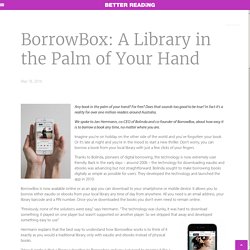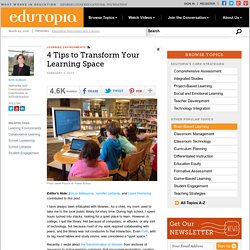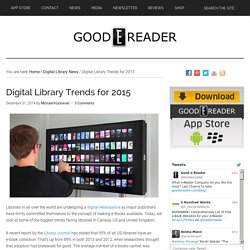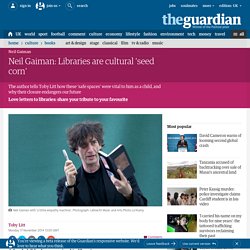

For the Love of Libraries. BorrowBox: A Library in the Palm of Your Hand – Better Reading. Any book in the palm of your hand?

For free? Does that sounds too good to be true? In fact it’s a reality for over one million readers around Australia. We spoke to Jan Herrmann, co-CEO of Bolinda and co-founder of BorrowBox, about how easy it is to borrow a book any time, no matter where you are. Imagine you’re on holiday on the other side of the world and you’ve forgotten your book. Thanks to Bolinda, pioneers of digital borrowing, the technology is now extremely user friendly. BorrowBox is now available online or as an app you can download to your smartphone or mobile device. “Previously, none of the solutions were easy,” says Herrmann. Herrmann explains that the best way to understand how BorrowBox works is to think of it exactly as you would a traditional library, only with eaudio and ebooks instead of physical books.
“How it works is that a library subscribes to Borrowbox and you just need to imagine it like a new branch. “It’s the same as loaning a book from a library. Facebook. A novel approach: Pamela Coyne Library. Despite the shift towards digital technologies and online learning resources, school libraries remain a place where the pleasures of reading and learning are shared and guided.

Yet in order to entice our young digital natives into the world of books, we must provide settings that are exciting and tech-rich, but also comfortable and homey – places students want to linger in. In keeping with these ideas, the recently renovated and expanded Pamela Coyne Library at St Monica College’s junior campus in Epping, Melbourne, is an example of how the twenty-first-century school library can reposition itself as the vital heart of the school community. Study: Good School Libraries Affect Test Scores. Columbia, SC (WLTX) - A study released Tuesday by the South Carolina Association of School Librarians shows that the more emphasis is put on school libraries--and the learning that takes place there--the better scores students receive on standardized tests.

University of South Carolina Professor Dr. Karen Gavigan outlined the studies five areas of importance at a press conference Tuesday morning. "The presence of librarians and library support staff, instructional collaboration between librarians and teachers, traditional and digital collections, library expenditures, and access to computers," she explained.
The study found that the schools which had these five components had better performance on the Palmetto Assessment of State Standards. One of third-grader Tavetria Amponsah's favorite things to do is to go to the library and read. School Librarian Debbie Cooper says the learning that takes place there is guided by collaboration between her and the teachers, but driven by the students. 4 Tips to Transform Your Learning Space. Editor's Note: Elissa Malespina, Jennifer LaGarde, and Laura Flemming contributed to this post.

I have always been infatuated with libraries. As a child, my mom used to take me to the local public library for story time. During high school, I spent hours tucked into stacks, looking for a quiet place to learn. Inspirational school libraries from around the world – gallery. Digital Library Trends for 2015. Libraries in all over the world are undergoing a digital renaissance as major publishers have firmly committed themselves to the concept of making e-Books available.

Today, we look at some of the biggest trends facing libraries in Canada, US and United Kingdom. A recent report by the Library Journal has stated that 95% of all US libraries have an e-book collection. That’s up from 89% in both 2013 and 2012, when researchers thought that adoption had plateaued for good. The average number of e-books carried was 20,244 by each library, but that of course was skewed toward large libraries. Medium sized libraries statistically had around 10,434 titles. Over 10 different libraries in the US and Canada had over one million digital loans in 2014, with two libraries lending out two million e-Books. E-Books are doing quite well in the US, but over in the UK a sustainable model is still trying to be established by the government, libraries and major publishers.
7 Big Myths About Libraries Neil Gaiman: Libraries are cultural 'seed corn' A feral child who was raised in libraries Toby Litt: You’ve described yourself as a “feral child who was raised in libraries”.

What age were you when you were first drawn into a library, and why do you think they hooked you? Neil: I was probably three or four when I first started going to libraries. We moved up to Sussex when I was five, and I discovered the local library very, very quickly. But I wasn’t really hooked until I got to the point where I was old enough to persuade my parents to just take me to the library and leave me there, which would have probably been about seven or eight. Toby: Was it, was it a brand-new, 1960s, idealistic, “we’ll educate the masses” library, or was it a slightly down-at-the-heel one?
Neil: It was a very large, respectable Victorian house, of the kind that looked like it might have once been an upmarket doctor’s practice. Toby: Approach the nest … Neil: I did. A shelf with unread books.